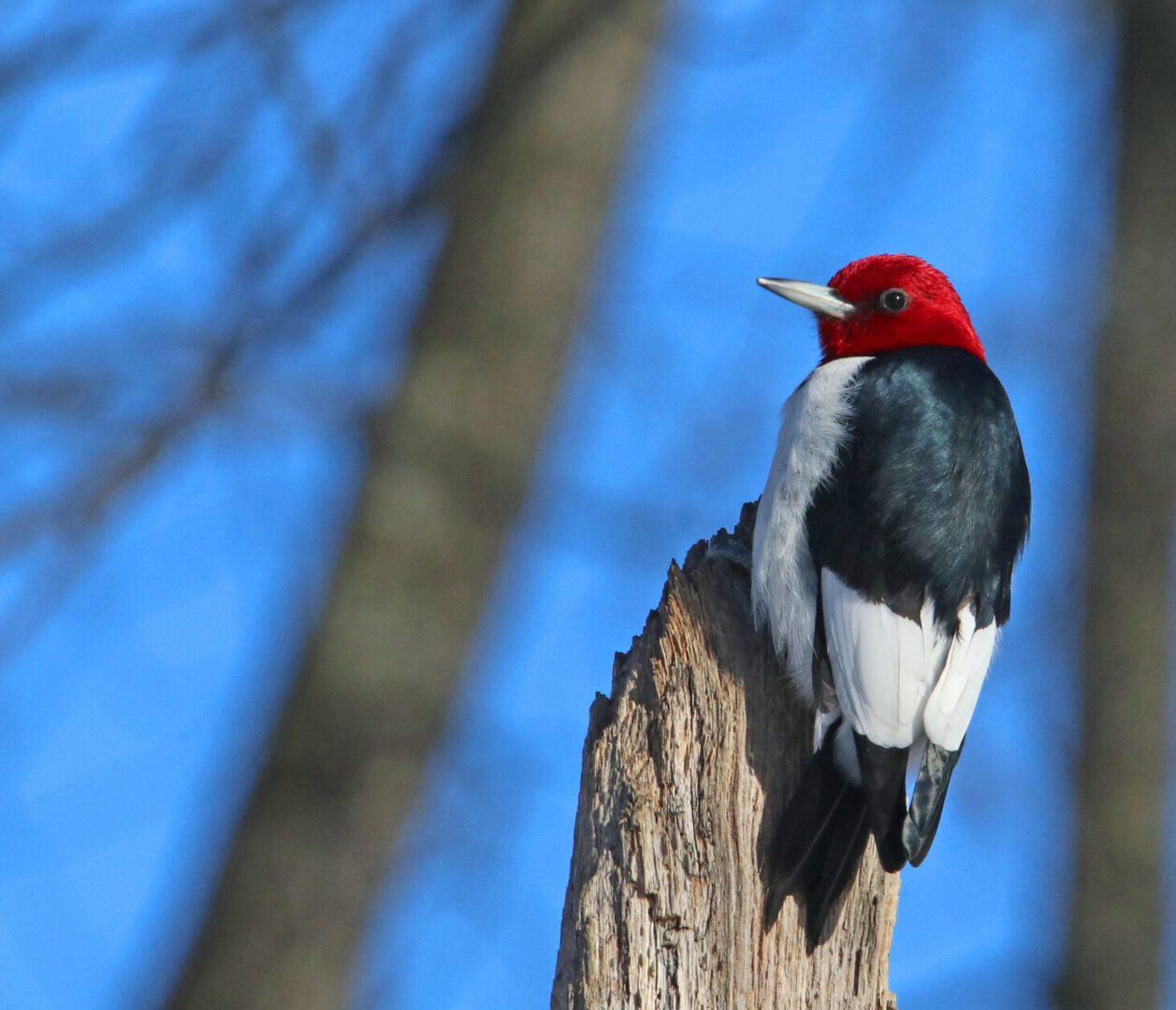
THE RED-HEADED woodpecker is easy to identify. (MARK NALE/For The Gazette)

THE RED-HEADED woodpecker is easy to identify. (MARK NALE/For The Gazette)
With its striking red, black and white plumage, the red-headed woodpecker is easy to identify. However, it is the rarest of all Pennsylvania woodpeckers. More numerous Keystone State woodpecker species include the pileated, downy, hairy and red-bellied woodpeckers, as well as the northern flicker and the yellow-bellied sapsucker. The pileated woodpecker is our largest species — the downy woodpecker is the smallest.
Surveys conducted for the first Atlas of Breeding Birds in Pennsylvania (1983-89) located the red-headed woodpecker in only 14% of the state’s survey blocks. Geographically, the population has declined in Pennsylvania by at least 46% since then. This woodpecker is being watched as a possible state-threatened species.
During the 1983-89 census period, Centre County — southeast of Route 220 — and the Tyrone/Bellwood area of Blair County had small populations of red-headed woodpeckers. By 2009, when the data collection for the second Breeding Bird Atlas was complete, the only possible breeding Blair County red-headed woodpeckers had been recorded east of Hollidaysburg. Quoting James Kellam in the latest Breeding Bird Atlas, “The future prospects for this species, in much of its former range in Pennsylvania, are decidedly bleak.”
The species is holding on in a few areas of Centre County, but the birds are not numerous by any stretch of the imagination. I am aware of a few breeding pairs in the Spring Mills area, and also at Bald Eagle State Park. I am sure there are a few others. During the past five years, red-headed woodpeckers have also nested at the Dreibelbis Birding Area in Huston Township and in Bell Hollow, Taylor Township. Both of those were one-year occurrences.
My most recent sighting of a Pennsylvania red-headed woodpecker occurred last year in Blair County, along the Ray Amato Trail behind the northern Blair Recreation Center. There is a colony of red-headed woodpeckers in Juniata County — maybe four breeding pairs — and I have taken photos there. With the exception of a few isolated Pennsylvania spots, the species is that rare.
This cavity nester shuns the big-woods country that is favored by the pileated woodpecker. Instead, it prefers mixed woodlot and farming country, open pine forests and river bottom habitat. This is the type of habitat where I first observed the bird in the 1960s.
Both sexes of adult red-headed woodpeckers are the same size and coloration. They measure approximately 8 inches tall, with a black and white body and a red head. They are the only eastern woodpecker with an entirely red head, so their name is very appropriate.
Although they are true woodpeckers, they do more than just peck at dead wood looking for insects. Their diverse feeding behaviors include stashing acorns like a blue jay, foraging on the ground like a robin or towhee, darting from a perch to catch flying insects like a phoebe or eastern kingbird and eating fruit like a catbird or cedar waxwing.
Beechnuts, acorns, seeds, insects, spiders, sumac berries, corn and even eggs or nestlings are all part of their varied diet. Red-headed woodpeckers are omnivorous (feeding on both plant and animal material) and opportunistic (concentrating on what is most available at the time) feeders. Redheads will sometimes visit bird feeders that offer suet, although this is not customary.
Populations of redheads have been declining for the past century. This is believed to be linked to the introduction of the European starling in New York City in 1890.
Starlings are aggressive birds that steal nest cavities from red-headed woodpeckers and other birds. Starlings first reached Centre County in 1916 and now live throughout the U.S. The starling population across the U.S. numbers in the hundreds of millions.
Other factors contributing to the decline of the red-headed woodpecker could be the cutting of dead trees necessary for nesting and the re-growth of Pennsylvania forests that followed the abandonment of small farms. However, no current data totally explains the declining populations and contraction of the species all across the northern boundary of its range.
Today, red-headed woodpeckers are most common in the central states, such as Illinois, Missouri, Iowa and Nebraska. On the plus side, here in Pennsylvania, are all of the ash trees killed by the emerald ash borer.
Males attract females to their territory and nesting sites. The male usually excavates a cavity from 8 to 65 feet in the air. The ones I have observed were 25 to 35 feet above the ground.
In Pennsylvania, nest building has been observed from May 3 to June 14. Most red-headed woodpeckers mate and lay eggs in June, with June 16 being the median date. Both sexes take turns incubating their five to seven eggs for about two weeks before they hatch. I feel fortunate to have had the chance to photograph red-headed woodpeckers several years ago in Virginia, and also in Juniata County. Maybe this year I will spot one closer to home.
Receive all the latest news and events right to your inbox.

80% of consumers turn to directories with reviews to find a local business.